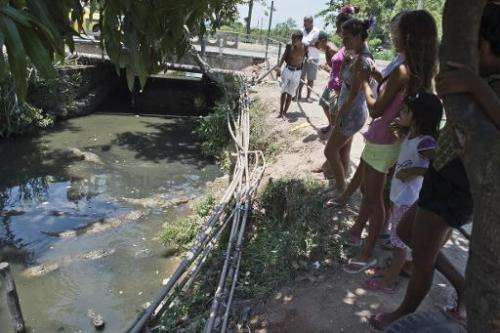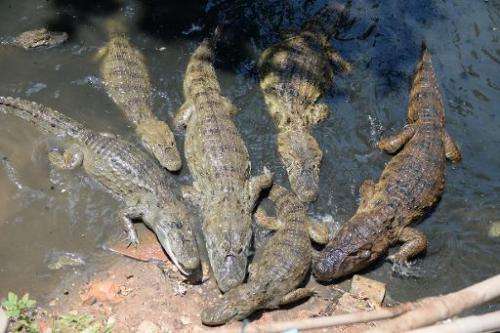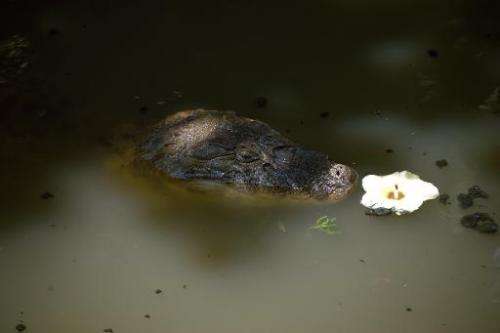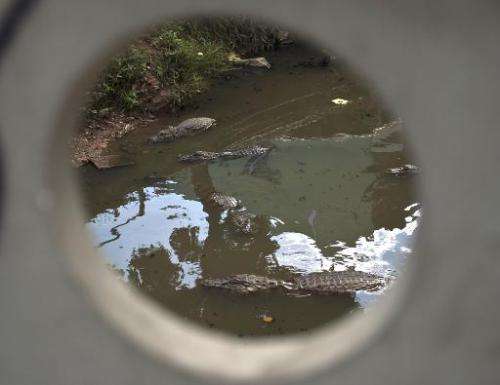Residents of the Tereirao shantytown in Recredo dos Bandeirantes, western Rio de Janeiro, watch broad-snouted caimans swimming in a ditch that goes through their neighbourhood
Residents of a Rio de Janeiro favela face a dangerous challenge in their quest for clean drinking water: a canal infested with hungry caimans, South America's alligator cousins.
With a severe drought that's left much of southeastern Brazil parched and the main water company accused of skimping on favela water supplies to benefit wealthier parts of town, residents are illegally tapping into a pipe near the reptile-filled canal.
"With this drought, we are often short of water and residents come here to stock up," says Alessandra dos Santos from the nearby Vila Amizade favela.
"They have to distract the caimans by throwing food."
The scene is repeated almost daily in this area of Recreio dos Bandeirantes just west of Rio, a few kilometers (miles) from a construction site for venues to be used in the 2016 Olympics.
Brazil has come under fire as it spends billions of dollars on the Summer Games while many residents remain mired in poverty.
Vila Amizade's vice president Marcos Conti told AFP that Rio water company Cedae sometimes rations water to the favelas before cutting the supply to residential areas. The water shortage is even worse in Sao Paulo.
Infested waters
At the favela entrance, people have fashioned illegal water connections to Cedae's main line that still has running water.
The place is known as "bica dos jacares" (caiman tap) where a huge pipe from Cedae passes above a narrow channel teeming with the scaly creatures.
Broad-snouted caimans (Caiman latirostris) are seen swimming in a ditch that goes through the Tereirao shantytown in Recredo dos Bandeirantes, western Rio de Janeiro
"They have already eaten a cat and ripped the leg of a dog," dos Santos says.
The caimans, which are a bit smaller than alligators, were said to have come from the increasingly polluted lagoons and marshes of a nearby ecological park.
"When it rains we are afraid because sometimes the water overflows and we have to push them back into the water with sticks," said resident Luciane de Oliveira, 36.
Claus Gordes, a retired engineer who has lived in a comfortable home near the slum for 18 years, said he has witnessed the "degradation" of the neighborhood.
"Before, this was forest and swamps, and then it became a slum that developed without any water or sewage infrastructure," he said.
A local biologist sees a dangerous situation that is being ignored by the government.
"People here live in filth, among mosquitoes and caimans, in totally unhealthy and inhumane conditions," says biologist Ricardo Freitas Filho, who runs a caiman institute.
"That's the reality of Rio de Janeiro, the wonderful city of the Olympics," he said sarcastically.
Caimans are slightly smaller than their cousins, alligators
Freitas Filho studies caimans, which live an average of about 70 years, and he worries their numbers are dropping as development and pollution take their toll.
Still, since 2005, he has tallied more than 500 of the animals in the polluted waters of the nearby lagoon.
Freitas Filho, who wears the same sort of wide-brimmed hat as Mick Dundee in the movie "Crocodile Dundee," said the government or the water company have not taken responsibility for the caiman infestation, even after the residential area has tripled in size.
He said he has identified a number of sewage outlets in the park coming from the water company that reduce oxygen in the lagoon and push the caimans to new territory.
Several broad-snouted caimans (Caiman latirostris) are seen swimming in a ditch that goes through the Tereirao shantytown in Recredo dos Bandeirantes, western Rio de Janeiro
"In search of a more favorable environment, the caiman is seen at the edge of the water or more often in the middle of town," Filho said.
"They should at least put up a sign telling people not to feed the animals, so they return to the lagoon," he said.
"They can sense food in the water from a distance of 1.5 kilometers and now they are expecting people to feed them."
© 2015 AFP


























